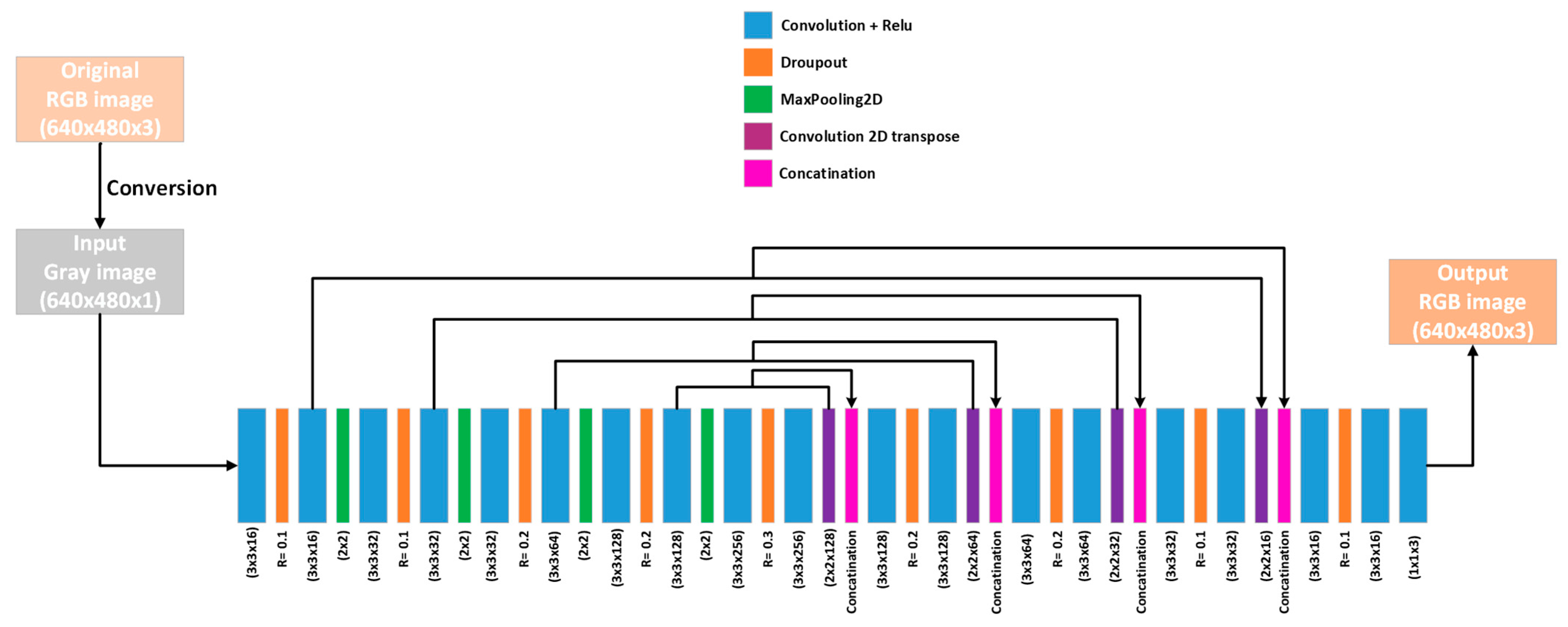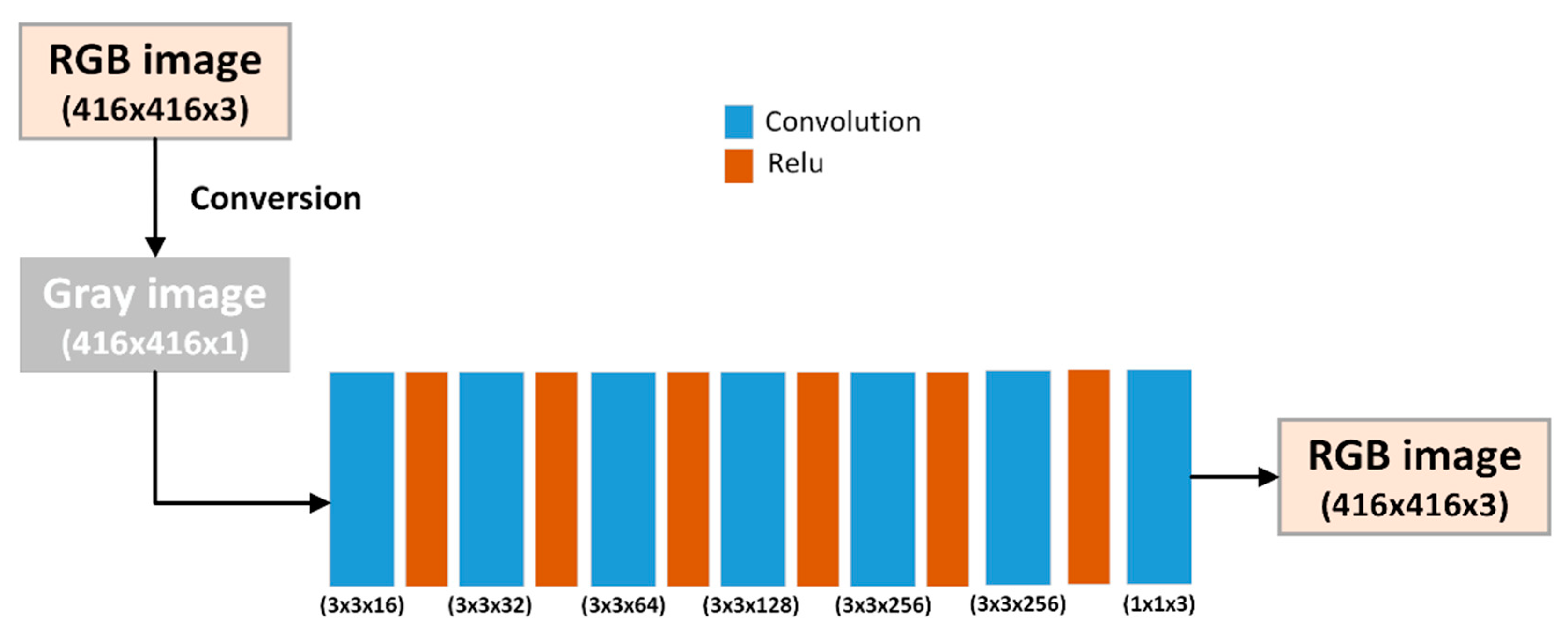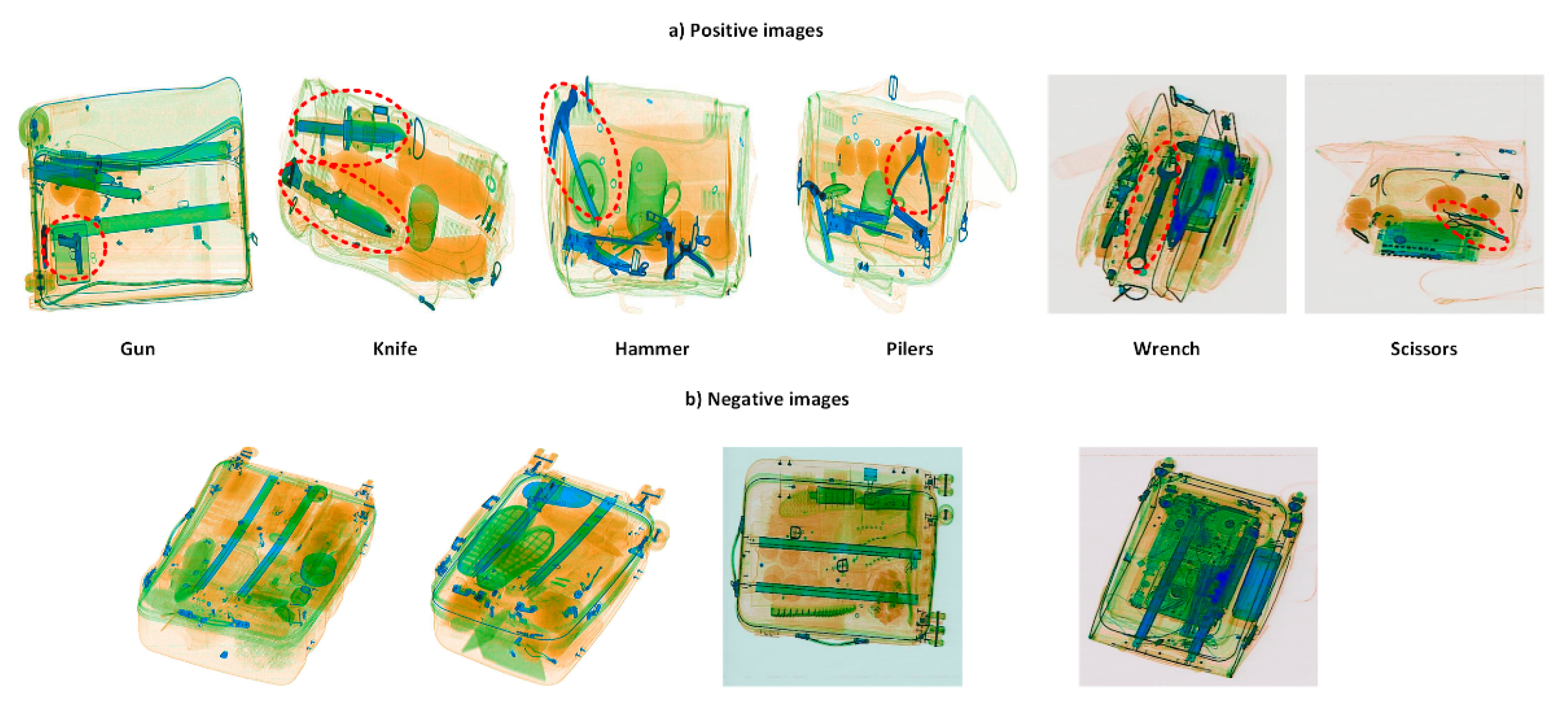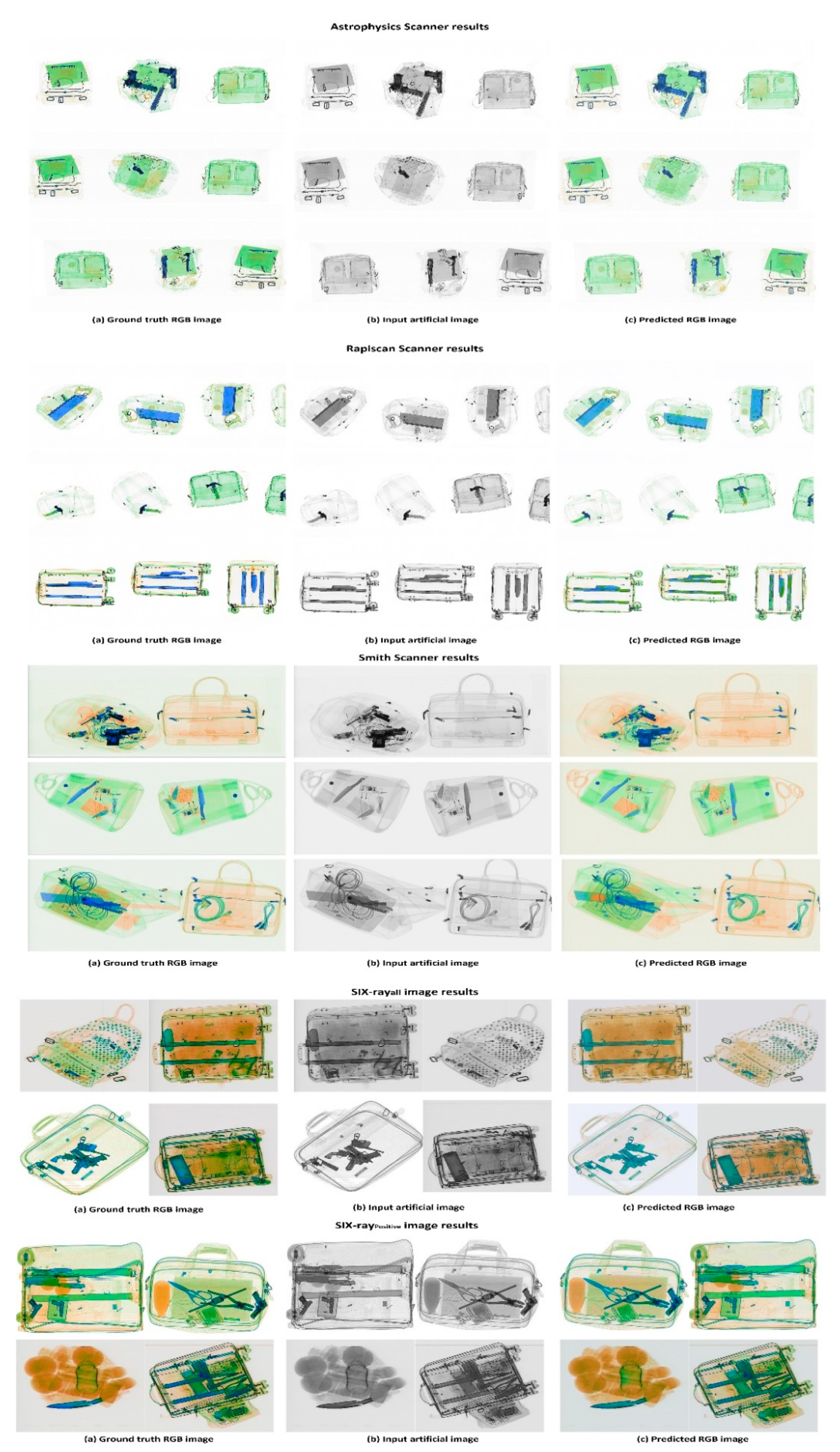Single Energy X-ray Image Colorization Using Convolutional Neural Network for Material Discrimination
Abstract
1. Introduction
- We propose a deep-learning-based X-ray image colorization method for raw X-ray images and artificially created raw images.
- We propose a single-energy colorization technique based on a CNN model trained on dual-energy colorization.
- We compare five different CNN architectures and select the best CNN model for the X-ray colorization task.
- We train the proposed model on images obtained from five different X-ray scanners, three of which are new datasets with a significant number of training and test images that have not been used in previous research.
- We prove that the artificially created raw image can be used instead of the original raw image, for X-ray colorization application.
2. Proposed Method
2.1. Proposed CNN Architecture
2.2. Training Detail
2.3. Loss Function
3. Experiment Preparation and Benchmarks
4. Evaluation Metric
5. Ablation Study
6. Results and Discussion
7. Application of the Proposed Method in Single-Energy X-ray Image Colorization
8. Limitations and Future Work
9. Conclusions
Author Contributions
Funding
Data Availability Statement
Conflicts of Interest
References
- Benedykciuk, E.; Denkowski, M.; Dmitruk, K. Material classification in X-ray images based on multi-scale CNN. Signal Image Video Process. 2021, 15, 1285–1293. [Google Scholar] [CrossRef]
- Alvarez, R.; Macovski, A. Energy-selective reconstructions in x-ray computerized tomography. Phys. Med. Biol. 1976, 21, 733–744. [Google Scholar] [CrossRef] [PubMed]
- Chuang, K.-S.; Huang, H.K. Comparison of four dual energy image decomposition methods. Phys. Med. Biol. 1988, 33, 455–466. [Google Scholar] [CrossRef]
- Osipov, S.; Usachev, E.; Chakhlov, S.; Shchetinkin, S.; Song, S.; Zhang, G.; Batranin, A.; Osipov, O. Limit capabilities of iden-tifying materials by high dual- and multi-energy methods. Rus. J. Nondestr. Test. 2019, 55, 687–699. [Google Scholar] [CrossRef]
- Benedykciuk, E.; Denkowski, M.; Dmitruk, K. Learning-Based Material Classification in X-Ray Security Images. In Proceedings of the 15th International Joint Conference on Computer Vision, Imaging and Computer Graphics Theory and Applications, Volume 4: VISAPP, Valletta, Malta, 27–29 February 2020; Farinella, G.M., Radeva, P., Braz, J., Eds.; SciTePress: Setúbal Municipality, Portugal, 2020; Volume 4, pp. 284–291. [Google Scholar]
- Brumbaugh, K.; Royse, C.; Gregory, C.; Roe, K.; Greenberg, J.A.; Diallo, S.O. Material classification using convolution neural network (CNN) for x-ray based coded aperture diffraction system. In Anomaly Detection and Imaging with X-rays (ADIX) IV; SPIE: Bellingham, WA, USA, 2019; Volume 10999. [Google Scholar] [CrossRef]
- Bunrit, S.; Kerdprasop, N.; Kerdprasop, K. Evaluating on the Transfer Learning of CNN Architectures to a Construction Material Image Classification Task. Int. J. Mach. Learn. Comput. 2019, 9, 201–207. [Google Scholar] [CrossRef]
- Szegedy, C.; Liu, W.; Jia, Y.; Sermanet, P.; Reed, S.; Anguelov, D.; Erhan, D.; Vanhoucke, V.; Rabinovich, A. Going Deeper with Convolutions. In Proceedings of the IEEE Conference on Computer Vision and Pattern Recognition, Boston, MA, USA, 7–12 June 2015; pp. 1–9. [Google Scholar]
- Chen, Z.-Q.; Zhao, T.; Li, L. A curve-based material recognition method in MeV dual-energy X-ray imaging system. Nucl. Sci. Tech. 2016, 27, 25. [Google Scholar] [CrossRef]
- Andrews, J.; Morton, E.; Griffin, L. Detecting anomalous data using auto-encoders. Int. J. Mach. Learn. Comput. 2016, 6, 21. [Google Scholar]
- Jaccard, N.; Rogers, T.W.; Morton, E.J.; Griffin, L.D. Detection of concealed cars in complex cargo X-ray imagery using Deep Learning. J. X-Ray Sci. Technol. 2017, 25, 323–339. [Google Scholar] [CrossRef]
- Kundegorski, M.; Akcay, S.; Devereux, M.; Mouton, A.; Breckon, T. On using Feature Descriptors as Visual Words for Object Detection within X-ray Baggage Security Screening. In Proceedings of the 7th International Conference on Imaging for Crime Detection and Prevention, Madrid, Spain, 23–25 November 2016. [Google Scholar] [CrossRef]
- Miao, C.; Xie, L.; Wan, F.; Su, C.; Liu, H.; Jiao, J.; Ye, Q. SIXray: A Large-Scale Security Inspection X-Ray Benchmark for Prohibited Item Discovery in Overlapping Images. In Proceedings of the 2019 IEEE/CVF Conference on Computer Vision and Pattern Recognition (CVPR), Long Beach, CA, USA, 15–20 June 2019; pp. 2119–2128. [Google Scholar]
- Roomi, M.M. Detection of Concealed Weapons in X-Ray Images Using Fuzzy K-NN. Int. J. Comput. Sci. Eng. Inf. Technol. 2012, 2, 187–196. [Google Scholar] [CrossRef]
- Akcay, S.; Breckon, T. Towards automatic threat detection: A survey of advances of deep learning within X-ray security imaging. arXiv 2020, arXiv:2001.01293. [Google Scholar] [CrossRef]
- Gaus, Y.F.A.; Bhowmik, N.; Breckon, T.P. On the Use of Deep Learning for the Detection of Firearms in X-ray Baggage Security Imagery. In Proceedings of the 2019 IEEE International Symposium on Technologies for Homeland Security (HST), Greater Boston, MA USA, 5–6 November 2019; pp. 1–7. [Google Scholar] [CrossRef]
- Girshick, R. Fast R-CNN. In Proceedings of the 2015 IEEE International Conference on Computer Vision (ICCV), Santiago, Chile, 7–13 December 2015; pp. 1440–1448. [Google Scholar] [CrossRef]
- He, K.; Gkioxari, G.; Dollár, P.; Girshick, R. Mask R-CNN. In Proceedings of the 2017 IEEE International Conference on Computer Vision (ICCV), Venice, Italy, 22–29 October 2017; pp. 2961–2969. [Google Scholar] [CrossRef]
- Lin, T.; Goyal, P.; Girshick, R.; He, K.; Dollár, P. Focal loss for dense object detection. In Proceedings of the IEEE International Conference on Computer Vision (ICCV), Venice, Italy, 22–29 October 2017; pp. 2999–3007. [Google Scholar]
- Flitton, G.; Breckon, T.; Megherbi, N. A comparison of 3D interest point descriptors with application to airport baggage object detection in complex CT imagery. Pattern Recognit. 2013, 46, 2420–2436. [Google Scholar] [CrossRef]
- Bhowmik, N.; Gaus, Y.F.A.; Akçay, S.; Barker, J.W.; Breckon, T.P. On the impact of object and sub-component level seg-mentation strategies for supervised anomaly detection within x-ray security imagery. In Proceedings of the 2019 18th IEEE International Conference On Machine Learning And Applications (ICMLA), Boca Raton, FL, USA, 16–19 December 2019; Wani, M.A., Khoshgoftaar, T.M., Wang, D., Wang, H., Seliya, N., Eds.; IEEE: Piscataway, NJ, USA, 2019; pp. 986–991. [Google Scholar]
- Wang, Y.; Morariu, V.I.; Davis, L.S. Learning a Discriminative Filter Bank Within a CNN for Fine-Grained Recognition. In Proceedings of the IEEE Conference on Computer Vision and Pattern Recognition, Salt Lake City, UT, USA, 18–23 June 2018; pp. 4148–4157. [Google Scholar] [CrossRef]
- Simonyan, K.; Zisserman, A. Very deep convolutional networks for large-scale image recognition. In Proceedings of the International Conference on Learning Representations (ICLR), San Diego, CA, USA, 7–9 May 2015. [Google Scholar]
- Iandola, F.N.; Han, S.; Moskewicz, M.W.; Ashraf, K.; Dally, W.J.; Keutzer, K. SqueezeNet: AlexNet-level accuracy with 50x fewer parameters and <0.5 MB model size. arXiv 2016, arXiv:1602.07360. [Google Scholar]
- He, K.; Zhang, X.; Ren, S.; Sun, J. Deep residual learning for image recognition. In Proceedings of the 2016 IEEE Conference on Computer Vision and Pattern Recognition (CVPR), Las Vegas, NV, USA, 27–30 June 2016; pp. 770–778. [Google Scholar]
- Stan, T.; Thompson, Z.T.; Voorhees, P.W. Optimizing convolutional neural networks to perform semantic segmentation on large materials imaging datasets: X-ray tomography and serial sectioning. Mater. Charact. 2020, 160, 110119. [Google Scholar] [CrossRef]
- Badrinarayanan, V.; Kendall, A.; Cipolla, R. SegNet: A Deep Convolutional Encoder-Decoder Architecture for Image Segmentation. IEEE Trans. Pattern Anal. Mach. Intell. 2017, 39, 2481–2495. [Google Scholar] [CrossRef]
- Roy, A.; Todorovic, S. A multi-scale CNN for affordance segmentation in RGB images. In ECCV (4). Lecture Notes in Computer Science; Leibe, B., Matas, J., Sebe, N., Welling, M., Eds.; Springer: Cham, Switzerland, 2016; Volume 9908, pp. 186–201. [Google Scholar]
- Ronneberger, O.; Fischer, P.; Brox, T. U-Net: Convolutional networks for biomedical image segmentation. In Proceedings of the International Conference on Medical Image Computing and Computer-Assisted Intervention, Munich, Germany, 5–9 October 2015; Springer: Berlin/Heidelberg, Germany, 2015; pp. 234–241. [Google Scholar]
- Goel, D.; Jain, S.; Vishwakarma, D.K.; Bansal, A. Automatic Image Colorization using U-Net. In Proceedings of the 12th International Conference on Computing Communication and Networking Technologies (ICCCNT), Kharagpur, India, 6–8 June 2021; pp. 1–7. [Google Scholar] [CrossRef]
- Billaut, V.; Rochemonteix, M.D.; Thibault, M. ColorUNet: A convolutional classification approach to colorization. arXiv 2018, arXiv:1811.03120. [Google Scholar]
- Nguyen-Quynh, T.-T.; Kim, S.-H.; Do, N.-T. Image Colorization Using the Global Scene-Context Style and Pixel-Wise Semantic Segmentation. IEEE Access 2020, 8, 214098–214114. [Google Scholar] [CrossRef]
- Di, Y.; Zhu, X.; Jin, X.; Dou, Q.; Zhou, W.; Duan, Q. Color-UNet++: A resolution for colorization of grayscale images using improved UNet++. Multimedia Tools Appl. 2021, 80, 35629–35648. [Google Scholar] [CrossRef]
- Zou, H.; Trevor, H. Regularization and Variable Selection via the Elastic Net. J. R. Stat. Soc. Ser. B (Stat. Methodol.) 2005, 67, 301–320. [Google Scholar] [CrossRef]
- X-ray Images of Hazardous Items. Available online: https://aihub.or.kr/aidata/33 (accessed on 25 March 2021).
- Griffin, L.D.; Caldwell, M.; Andrews, J.; Bohler, H. ‘Unexpected Item in the Bagging Area’: Anomaly Detection in X-Ray Security Images. IEEE Trans. Inf. Forensics Secur. 2019, 14, 1539–1553. [Google Scholar] [CrossRef]
- Mery, D.; Riffo, V.; Zscherpel, U.; Mondragon, G.; Lillo, I.; Zuccar, I.; Lobel, H.; Carrasco, M. GDXray: The Database of X-ray Images for Nondestructive Testing. J. Nondestruct. Eval. 2015, 34, 42. [Google Scholar] [CrossRef]
- Wang, Z.; Bovik, A.; Sheikh, A.; Simoncelli, E. Image Quality Assessment: From Error Visibility to Structural Similarity. IEEE Trans. Image Process. 2004, 13, 600–612. [Google Scholar] [CrossRef] [PubMed]
- Zhang, R.; Isola, P.; Efros, A.A.; Shechtman, E.; Wang, O. The Unreasonable Effectiveness of Deep Features as a Perceptual Metric. In Proceedings of the IEEE Conference on Computer Vision and Pattern Recognition, Salt Lake City, UT, USA, 18–23 June 2018; pp. 586–595. [Google Scholar] [CrossRef]
- Chollet, F. Deep Learning with Python; Manning Publications: New York, NY, USA, 2017; ISBN 9781617294433. [Google Scholar]
- Chollet, F. Xception: Deep learning with depthwise separable convolutions. In Proceedings of the 2017 IEEE Conference on Computer Vision and Pattern Recognition (CVPR), Honolulu, HI, USA, 21–26 July 2017. [Google Scholar]
- Anwar, S.; Tahir, M.; Li, C.; Mian, A.; Khan, F.S.; Muzaffar, A.W. Image colorization: A survey and dataset. arXiv 2020, arXiv:2008.10774. [Google Scholar]
- Yagoub, B.; Ibrahem, H.; Salem, A.; Suh, J.-W.; Kang, H.S. X-ray image denoising for Cargo Dual Energy Inspection System. In Proceedings of the 2021 International Conference on Electronics, Information, and Communication (ICEIC), Jeju, Republic of Korea, 31 January–3 February 2021; pp. 1–4. [Google Scholar] [CrossRef]
- Wang, H.W.; Xue, Y.J.; Ma, Y.L.; Hua, N.; Ma, H.Y. Determination of quantum toric error correction codethreshold using convolutional neural network decoders. Chin. Phys. B 2021, 31, 010303. [Google Scholar] [CrossRef]
- Rahman, S.; Rahman, M.; Abdullah-Al-Wadud, M.; Al-Quaderi, G.D.; Shoyaib, M. An adaptive gamma correction for image enhancement. EURASIP J. Image Video Process. 2016, 2016, 35. [Google Scholar] [CrossRef]
- Liu, D.; Liu, J.; Yuan, P.; Yu, F. A Data Augmentation Method for Prohibited Item X-Ray Pseudocolor Images in X-Ray Security Inspection Based on Wasserstein Generative Adversarial Network and Spatial-and-Channel Attention Block. Comput. Intell. Neurosci. 2022, 2022, 8172466. [Google Scholar] [CrossRef]







| Z Number | Material Type | 3 Colors | 6 Colors | Example | Possible Threats |
|---|---|---|---|---|---|
| 0–8 | Organic | Orange | Brown | Wood, Oil | C-4, TNT, Semtex |
| 8–10 | Low inorganic | Orange | Orange | Paper | Cocaine, Heroin |
| 10–12 | High inorganic | Green | Yellow | Glass | Propellants |
| 12–17 | Light metal | Green | Green | Aluminum, Silicon | Gunpowder, Trigger devices |
| 17–29 | Heavy metal | Blue | Blue | Iron, Steel | Guns, Bullets, Contraband |
| 29+ | Dense metal | Blue | Violet | Gold, Silver | High value contraband |
| - | Impenetrable | Black | Black | Lead | Shielding for above threats |
| PSNR | SSIM | LPIPS | |
|---|---|---|---|
| UNet | 33.637 | 0.9680 | 0.0144 |
| UNet-22 | 32.556 | 0.9663 | 0.0256 |
| UNet-54 | 30.790 | 0.9689 | 0.0284 |
| Xception–UNet | 23.302 | 0.7906 | 0.2828 |
| DCNN | 32.960 | 0.9706 | 0.0200 |
| Rapiscan | Astrophysics | Smith | SIXrayall | SIXrayPositive | COMPASS-XP | |
|---|---|---|---|---|---|---|
| Loss ↓ | 0.0050 | 0.0040 | 0.0087 | 0.0146 | 0.0189 | 0.0079 |
| Validation loss ↓ | 0.0115 | 0.0143 | 0.0261 | 0.0488 | 0.0287 | 0.0113 |
| PSNR (RGB) ↑ | 29.4123 | 28.6951 | 27.7374 | 22.6113 | 27.1444 | 33.6374 |
| SSIM ↑ | 0.9772 | 0.9752 | 0.9192 | 0.9243 | 0.9428 | 0.9680 |
| LPIPS ↓ | 0.0480 | 0.0253 | 0.1169 | 0.1801 | 0.1149 | 0.0144 |
| Input Image. | Loss ↓ | Validation Loss ↓ | PSNR ↑ | SSIM ↑ | LPIPS ↓ |
|---|---|---|---|---|---|
| Artificial | 0.0079 | 0.0113 | 33.63743 | 0.96805576 | 0.02403 |
| Raw | 0.0072 | 0.0155 | 31.81399 | 0.96701482 | 0.02481 |
Publisher’s Note: MDPI stays neutral with regard to jurisdictional claims in published maps and institutional affiliations. |
© 2022 by the authors. Licensee MDPI, Basel, Switzerland. This article is an open access article distributed under the terms and conditions of the Creative Commons Attribution (CC BY) license (https://creativecommons.org/licenses/by/4.0/).
Share and Cite
Yagoub, B.; Ibrahem, H.; Salem, A.; Kang, H.-S. Single Energy X-ray Image Colorization Using Convolutional Neural Network for Material Discrimination. Electronics 2022, 11, 4101. https://doi.org/10.3390/electronics11244101
Yagoub B, Ibrahem H, Salem A, Kang H-S. Single Energy X-ray Image Colorization Using Convolutional Neural Network for Material Discrimination. Electronics. 2022; 11(24):4101. https://doi.org/10.3390/electronics11244101
Chicago/Turabian StyleYagoub, Bilel, Hatem Ibrahem, Ahmed Salem, and Hyun-Soo Kang. 2022. "Single Energy X-ray Image Colorization Using Convolutional Neural Network for Material Discrimination" Electronics 11, no. 24: 4101. https://doi.org/10.3390/electronics11244101
APA StyleYagoub, B., Ibrahem, H., Salem, A., & Kang, H.-S. (2022). Single Energy X-ray Image Colorization Using Convolutional Neural Network for Material Discrimination. Electronics, 11(24), 4101. https://doi.org/10.3390/electronics11244101







